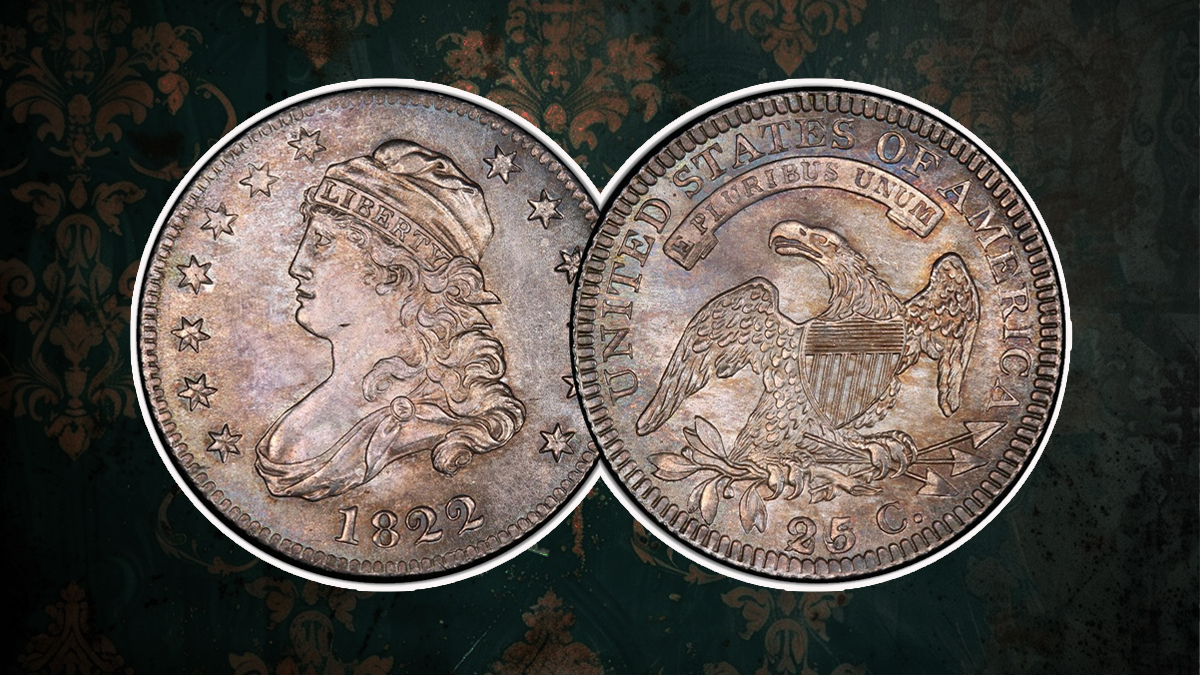
For coin collectors, the 1822 Capped Bust Quarter is a priceless thing that describes early 19th-century American numismatics. This quarter is unique for its beautiful design and historical value, as it was made at a time when the US was growing and developing. In this article, we’ll explore the 1822 Capped Bust Quarter’s history, specification, design, rarity & condition, and value.
The Capped Bust series was made between 1815 and 1838, with the 1822 Capped Bust Quarter. In this series, the U.S. Mint tried to improve the artistic quality and reliability of its coinage, keeping the tradition that began with the Draped Bust design. Chief Engraver John Reich’s Capped Bust design is known for its delicate and elegant beauty.
History of 1822 Capped Bust Quarter
In 1807, the Capped Bust design was had in US coins. It was presented on half dollars and then moved to other values. From 1815 onwards, the quarter, which had before been struck only rarely, began more regular production. The 1822 quarter is an essential characteristic of understanding the history of American coinage since it is from this early manufacturing time.
Specifications
- Composition: 89.24% silver, 10.76% copper
- Diameter: 27 mm
- Weight: 6.74 grams
- Edge: Reeded
- Mint Mark: None (all were minted in Philadelphia)
Basic Design
Obverse
The obverse side of the 1822 Capped Bust Quarter features a right-facing body of Liberty, decorated with a Phrygian cap labeled with the phrase “LIBERTY”. Her hair flows gracefully under the cap, and she is surrounded by thirteen stars representing the earliest colonies. The date “1822” is placed below Liberty’s image.
Reverse
The reverse side shows an eagle with outstretched wings, clutching an olive branch and arrows, representing peace and enthusiasm for security. The eagle’s chest is protected, and above its head is a banner with the tagline “E PLURIBUS UNUM”. Surrounding the eagle are the captions “UNITED STATES OF AMERICA” and “25 C.”, showing the quarter dollar denomination.
Rarity and Condition
The 1822 Capped Bust Quarter is believed rare, especially in higher grades. The total mintage for the year was rather low, with estimations offering around 64,080 coins were made. Many of these coins have not stayed in high grades due to circulation wear and the passage of time.
Grading and Value
The value of an 1822 Capped Bust Quarter varies especially based on its condition:
- Good (G-4): In this grade, the coin shows heavy wear, with the date and major details still visible. These can be valued almost $200 to $300.
- Fine (F-12): The coin shows moderate wear with more details visible in Liberty’s hair and the eagle’s feathers. Values can vary from $400 to $600.
- Very Fine (VF-20): Here, the coin has sharp details with minor wear on high points. Values generally range from $800 to $1,200.
- Extremely Fine (EF-40): The coin has light wear and has strong detail, valued from $1,500 to $2,500.
- About Uncirculated (AU-50): This grade shows slight traces of wear on the most elevated points, with values from $3,000 to $5,000.
- Mint State (MS-60 and above): Coins in mint state are very rare and can command prices upwards of $10,000 to $20,000, depending on the specific grade and eye attraction.
According to Enthusiasts, the value of an 1822 Capped Bust Quarter in the average circulated condition is estimated at $823, while one in certified mint state (MS+) condition could be valued as high as $74,798.
Also Read – 1842 O Liberty Seated Quarter: A Collector’s Guide
Conclusion
The 1822 Capped Bust Quarter stands as a testament to early American coinage artistry and the rich history of the United States Mint. Its rarity and historical context make it a highly sought-after piece among collectors. Whether seen in circulated condition or as a mint state gem, the 1822 quarter is an important and valuable addition to any collection. As you delve into the world of numismatics, the Capped Bust series suggests a fascinating glimpse into the past, with the 1822 quarter being an excellent example of early American craftsmanship and heritage.
